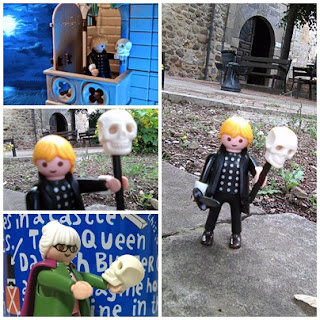The Tempest is a play by William Shakespeare, probably written in 1610-1611, and thought to be one of the last plays that he wrote alone.
After the first scene, which takes place on a ship at sea during a tempest, the rest of the story is set on a remote island, where Prospero, a complex and contradictory character, lives with his daughter Miranda, and his two servants: Caliban, a savage monster figure, and Ariel, an airy spirit.
The play contains music and songs that evoke the spirit of enchantment on the island. It explores many themes, including magic, betrayal, revenge, and family. In Act IV, a wedding masque serves as a play-within-a-play, and contributes spectacle, allegory, and elevated language.
Although The Tempest is listed in the First Folio as the first of Shakespeare's comedies, it deals with both tragic and comic themes, and modern criticism has created a category of romance for this and others of Shakespeare's late plays.
The Tempest has been put to varied interpretations, from those that see it as a fable of art and creation, with Prospero representing Shakespeare, and Prospero's renunciation of magic signaling Shakespeare's farewell to the stage, to interpretations that consider it an allegory of Europeans colonizing foreign lands.
It is not known for certain exactly when The Tempest was written, but evidence supports the idea that it was probably composed sometime between late 1610 to mid-1611. It is considered one of the last plays that Shakespeare wrote alone. Evidence supports composition perhaps occurring before, after, or at the same time as The Winter's Tale. Edward Blount entered The Tempest into the Stationers' Register on 8 November 1623. It was one of 16 Shakespeare plays that Blount registered on that date.
There is no obvious single origin for the plot of The Tempest; it appears to have been created with several sources contributing, chiefly William Strachey's Letter to an Excellent Lady. Since source scholarship began in the eighteenth century, researchers have suggested passages from Naufragium (The Shipwreck), one of the colloquies in Erasmus's Colloquia Familiaria (1518), and Richard Eden's 1555 translation of Peter Martyr's De orbo novo (1530).
The Tempest may take its overall structure from traditional Italian commedia dell'arte, which sometimes featured a magus and his daughter, their supernatural attendants, and a number of rustics. The commedia often featured a clown known as Arlecchino (or his predecessor, Zanni) and his partner Brighella, who bear a striking resemblance to Stephano and Trinculo; a lecherous Neapolitan hunchback who corresponds to Caliban; and the clever and beautiful Isabella, whose wealthy and manipulative father, Pantalone, constantly seeks a suitor for her, thus mirroring the relationship between Miranda and Prospero.
The Tempest first appeared in print in 1623 in the collection of 36 of Shakespeare's plays entitled, Mr. William Shakespeare's Comedies, Histories, & Tragedies; Published according to the True and Original Copies, which is known as the First Folio. The plays, including The Tempest, were gathered and edited by John Heminges and Henry Condell.
More information: Spark Notes
The Tempest by William Shakespeare
Hell is empty and all the devils are here.
Ariel, The Tempest (Act 1, Scene 2)

.jpg)

.jpg)
%20(1).jpg)

.jpg)



